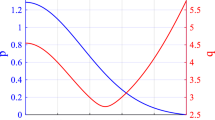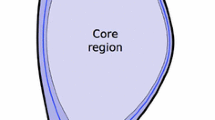Abstract
Plasma dynamics has been investigated intensively for toroidal magnetic confinement in tokamaks with the aim to develop a controlled thermonuclear energy source. On the other hand, it is known that more than 90% of visible matter in the universe consists of plasma, so that the discipline of plasma-astrophysics has an enormous scope. Magnetohydrodynamics (MHD) provides a common theoretical description of these two research areas where the hugely different scales do not play a role. It describes the interaction of electrically conducting fluids with magnetic fields that are, in turn, produced by the dynamics of the plasma itself. Since this theory is scale invariant with respect to lengths, times, and magnetic field strengths, for the nonlinear dynamics it makes no difference whether tokamaks, solar coronal magnetic loops, magnetospheres of neutron stars, or galactic plasmas are described. Important is the magnetic geometry determined by the magnetic field lines lying on magnetic surfaces where also the flows are concentrated.
Yet, transfer of methods and results obtained in tokamak research to solar coronal plasma dynamics immediately runs into severe problems with trans‘sonic’ (surpassing any one of the three critical MHD speeds) stationary flows. For those flows, the standard paradigm for the analysis of waves and instabilities, viz. a split of the dynamics in equilibrium and perturbations, appears to break down. This problem is resolved by a detailed analysis of the singularities and discontinuities that appear in the trans‘sonic’ transitions, resulting in a unique characterization of the permissible flow regimes. It then becomes possible to initiate MHD spectroscopy of axi-symmetric transonic astrophysical plasmas, like accretion disks or solar magnetic loops, by computing the complete wave and instability spectra by means of the same methods (with unprecedented accuracy) exploited for tokamak plasmas. These large-scale linear programs are executed in tandem with the non-linear (shock-capturing, massively parallel) Versatile Advection Code to describe both the linear and the nonlinear phases of the instabilities.
Similar content being viewed by others
References
Belië n, A. J. C., Botchev, M. A., Goedbloed, J. P., van der Holst, B. and Keppens, R.: 2002, J.Comp.Phys. 182, 91.
Belië n, A. J. C., Goedbloed, J. P. and Van der Holst, B.: 2001, Proc. 28th Eur. Conf. on Controlled Fusion and Plasma Physics, Madeira, p. 1309.
Belië n, A. J. C., Martens, P. C. H. and Keppens, R.: 1999, in Plasma Dynamics and Diagnostics in the Solar Transition Region and Corona, 8th SOHO Workshop, ESA SP-446, 167-172.
Belië n, A. J. C., Poedts, S. and Goedbloed, J. P.: 1997, Phys.Rev.Lett. 76, 567-570; in Magnetodynamic Phenomena in the Solar Atmosphere-Prototypes of stellar magnetic activity, IAU Coll. 153, 423-424 (Kluwer Dordrecht, 1996); Astron.Astrophys. 322, 995-1006 (1997); Comp.Phys.Comm. 106, 21-38 (1997); in The Corona and Solar Wind near Minimum Activity, 5th SOHO Workshop, ESA SP-404, 193-197 (1997).
Bernstein, I. B., Frieman, E. A., Kruskal, M. D. and Kulsrud, R. M.: 1958, Proc.Roy.Soc.London A244, 17-40.
Frieman, E. and Rotenberg, M.: 1960, Rev.Mod.Phys. 32, 898-902.
Goedbloed, J. P.: 2002, Physica Scripta T98, 43-47.
Goedbloed, J. P.: 1975, Phys.Fluids 18, 1258-1268.
Goedbloed, J. P., Huysmans, G. T. A., Holties, H., Kerner, W. and Poedts, S.: 1993, Plasma Phys.Contr.Fusion 35, B277-292.
Goedbloed, J. P. and Lifschitz, A.: 1997, Phys.Plasmas 4, 3544.
Halberstadt, G. and Goedbloed, J. P.: 1995, Astron.Plasmas 301, 577-592; 280, 647-660 (1993); 286, 265-301 (1994); 301, 559-576 (1995).
Hameiri, E.: 1983, Phys.Fluids 26, 230-237.
Huysmans, G. T. A., Goedbloed, J. P. and Kerner, W.: 1991, in Comput.Phys. 371(World Scientific, 1991).
Keppens, R. and Goedbloed, J. P.: 2000, Astron.Astrophys. 343, 251-260 (1999); Space Sci.Rev. 87, 223-226 (1999); Astrophys.J 530, 1036-1048.
Keppens, R. and Tó th, G.: 2000, in Third International Conference for Vector and Parallel Processing, Lecture Notes in Computer Science 1573, 680-690 (Springer, 1999)
Keppens, R., Tó th, G. and Goedbloed, J.P.: 2000, in Pallallel Computing: Fundamentals and Applications, ParCo99, 160-167, Imperial College Press, London.
Keppens, R., Casse, F. and Goedbloed, J. P.: 2002, Astrophys.J. 569, L121-L126.
Keppens, R., Nool, M. and Goedbloed, J. P.: 2002, in Pallallel Computational Fluid Dynamics-Practice and Theory, 215-223 (Elsevier Science, 2002); Nool,M. and Keppens, R.: 2002, Comp.Math.Appl.Math 2, 92-109.
Keppens, R., Tó th, G., Westermann, R. H. J. and Goedbloed, J. P.: 1999, J.Plasma Phys. 61, 1-19 (1999); Keppens, R. and Tó th, G.: 1999, Phys.of Plasmas 6, 1461-1469.
Keppens, R., Poedts, S., Meijer, P. M. and Goedbloed, J. P., in High Performance Computing and Networking, Lecture Notes in Computer Science 1225, 190-199 (Springer, 1997); Keppens, R., Poedts, S. and Goedbloed, J. P., in High Performance Computing and Networking, Lecture Notes in Computer Science 1401, 233-241 (Springer, 1998).
Kerner, W., Goedbloed, J. P., Huysmans, G. T. A., Poedts, S. and Schwarz, E.: 1998, J.Comp.Phys. 142, 271-303.
MPP-CMFD team, ed.
Poedts, S., Keppens, R. and Goedbloed, J. P.: 2000, 1st, 2nd, 3rd, Final Annual Report of the Massively Parallel Computing Cluster Project 95MPR04, Rijnhuizen Reports 96-231 (1996); 97-233 (1997); 98-234 (1998); 00-235 (2000).
Poedts, S. and Goedbloed, J. P., in Magnetodynamic Phenomena in the Solar Atmosphere-Prototypes of Stellar Magnetic Activity, IAU Coll. 153, 425-426 (Kluwer Dordrecht, 1996); Astron.Astrophys. 321, 935-944 (1997); Poedts, S., Tó th, G., Belië n, A. J. C. and Goedbloed, J.P., Solar Physics 172, 45-52 (1997).
Sleijpen, G. L. G. and Van der Vorst, H. A.: 1996, SIAM J.Matrix Anal.Appl. 17, 401.
Tó th, G.: 1996, Astrophys.Lett.Comm. 34, 245.
Van der Holst, B., Belië n, A. J. C. and Goedbloed, J. P.: 2003, (in press).
Van der Holst, B., Belië n, A. J. C. and Goedbloed, J. P.: 2000, Phys.Rev.Lett. 84, 2865; Phys.Plasmas 7, 4208.
Van der Holst, B., Belië n, A. J. C., Goedbloed, J. P., Nool, M. and Van der Ploeg, A.: 1999, Phys.Plasmas 6, 1554-1561.
Zehrfeld, H. P. and Green, B. J.: 1972, Nuclear Fusion 12, 569-575.
Author information
Authors and Affiliations
Rights and permissions
About this article
Cite this article
Goedbloed, J., Keppens, R. & Poedts, S. Computer simulations of solar plasmas. Space Science Reviews 107, 63–80 (2003). https://doi.org/10.1023/A:1025551117617
Issue Date:
DOI: https://doi.org/10.1023/A:1025551117617




